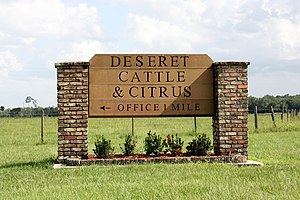Deseret Ranch

Deseret Ranches (/ˌdɛzəˈrɛt/ ⓘ)[1] refers to the ranching operations of the Corporation of the President of The Church of Jesus Christ of Latter-day Saints in Central Florida. The Ranches include several organizations, including Deseret Ranches of Florida, Deseret Cattle and Citrus, Taylor Creek Management, East Central Florida Services, AgReserves, and Farmland Reserve. Located 50 miles (80 km) southeast of the Orlando International Airport and 19 miles (31 km) west of Cape Canaveral, Florida.[2][3] Currently, Deseret Ranches is the most productive cow-calf ranch in the United States.[4]
Geography

This ranch, owned by The Church of Jesus Christ of Latter-day Saints (LDS Church), spreads over the three central Florida counties of Osceola, Orange, and Brevard. Covering almost 300,000 acres (1,200 km2) of land,[3][5] 90 ranchers and their families live on the ranch. The ranch maintains 44,000 head of beef cattle.[3][6] It is a for-profit operation and is not a normal part of the humanitarian efforts of the LDS Church. Gordon B. Hinckley, former president of the church, has said, "We have felt that good farms, over a long period, represent a safe investment where the assets of the Church may be preserved and enhanced, while at the same time, they are available as an agricultural resource to feed people should there come a time of need."[7]
History
The earliest plans for this ranch were made in 1949, and in 1950 the original 45,000 acres (180 km2) were purchased. Deseret Ranch now covers an area 50 by 30 miles (80 by 48 km), with a separate section surrounding Kenansville in Osceola County.
The church bought the original 54,000-acre (220 km2) tract in 1950 and over 50 years, the ranch grew to more than 312,000 acres (1,260 km2). In 1997 it was the world's largest beef ranch, and the land was worth an estimated $858 million.[8]
Operations
Like their other financial details, the LDS Church does not disclose the revenue or valuation of the ranch. Still, it is known that in 2000, they moved 16 million pounds (7300 t) of calves, which then translated to about $16 million in revenue. In 2008, Deseret Ranch discussed selling part of the property for a development near Orlando, Florida, but the proposed rezoning was withdrawn before approval.[9][10]
The Deseret Ranch also brings in revenue from the mining of native shell beds (used throughout Florida to pave roads), orange groves, hunting permits, and sales of ornamental palm trees.
In 2011, having won control of some of its water from the St. Johns River Water Management District, it was planning on selling some to Cocoa, Florida.[11]
See also
Notes
- ^ churchofjesuschrist.org: "Book of Mormon Pronunciation Guide" (retrieved 2012-02-25), IPA-ified from «dĕz-a-rĕt´»
- ^ Barnett, Cynthia (December 2001), "The Church's Ranch: The Mormon church runs one of the biggest and most profitable cattle operations in the U.S. on a 300,000-acre ranch covering parts of Orange, Brevard, and Osceola counties" (PDF), Florida Trend
- ^ a b c Hollenhorst, John (18 May 2011), LDS Church ranch making big impact in Florida, KSL-TV
- ^ "Culture Clash". Host: Brian Unger. How the States Got Their Shapes. A&E Television Networks. The History Channel. 5-Jul-11. 44 minutes in.
- ^ Ranching from Deseret Ranches webpage. Archived October 18, 2008, at the Wayback Machine
- ^ Cattle from Deseret Ranches webpage. Archived October 17, 2008, at the Wayback Machine
- ^ Hinckley, Gordon B. (May 1991), "The State of the Church", Ensign
- ^ Biema, 1997[full citation needed]
- ^ Spear, Kevin (8 July 2008). Deseret Ranch owners pull request to rezone property. Orlando Sentinel.
- ^ Spear, Kevin (13 October 2008). Could Deseret Ranch morph into a metro area larger than Orlando?. Orlando Sentinel. Last accessed 15 May 2009. Archived October 25, 2008, at the Wayback Machine
- ^ Berman, Dave (January 15, 2012). "Deal allows Cocoa to sell, use Taylor Creek water". Florida Today. Melbourne, Florida. pp. 1B.
Further reading
- "News Story: Church-Owned Ranch Balances Agriculture and Conservation in Central Florida", MormonNewsroom.org, LDS Church, 1 April 2016
- "From book to boom: how the Mormons plan a city for 500,000 in Florida" – The Guardian
External links
- Deseret Ranches official site